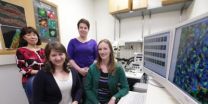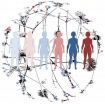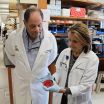(Press-News.org) Scientists at the Naval Research Laboratory (NRL) are part of a research team that has detected water vapor in the atmosphere of a planet outside our solar system. The team, including scientists from California Institute of Technology, Harvard-Smithsonian Center for Astrophysics, Pennsylvania State University, and University of Arizona, applied a sophisticated Doppler technique to the infrared to directly detect the planet and demonstrate the presence of water in its atmosphere. The discovery is described in the March 10, 2014 issue of The Astrophysical Journal Letters.
The planet, named tau Boo b, orbits the nearby star tau Boötis and belongs to a class of exotic planets called "hot Jupiters" that are not found in our solar system. A hot Jupiter is a massive extrasolar planet that orbits very close to its parent star. Unlike our Jupiter, which is fairly cold and has an orbital period of about 12 years, tau Boo b orbits its star every 3.3 days and is heated to extreme temperatures by its proximity to the star. Under these conditions, water will exist as a high temperature steam. While hot Jupiters are found to be relatively common in the Galaxy, the origin and nature of these planets remain the subject of intense research.
The research team studied data collected at the W.M. Keck Observatory in Hawaii, using the Near Infrared Echelle Spectrograph instrument. Because a hot Jupiter is too close to its star to separate the planet's light from that of the star, the researchers adapted a Doppler technique previously used to detect low mass-ratio spectroscopic binary stars. Application of this method to tau Boo b, however, posed a huge challenge, because the infrared radiation from the star is more than 10,000 times greater than that of the planet. The analysis software to extract this minute planetary signal was developed by Chad Bender, a Penn State member of the team, while he was a National Research Council Associate at NRL.
By comparing the molecular signature of water to the combined light spectrum of the planet and star, the scientists were able to measure the motion of the planet as it orbits the star and establish the presence of water vapor in the planet's atmosphere. The team also determined that the planet is six times more massive than Jupiter.
Dr. John Carr, a researcher in NRL's Remote Sensing Division and co-author on the paper, said, "The detection of water vapor in tau Boo b is an exciting and important step in understanding the composition of these exotic planets. Our result also demonstrates the power of this technique for measuring water and other molecules in the atmospheres of planets, giving us a new tool to study the nature and evolution of extrasolar planets."
Prior to this, scientists have reported detections of water for just a few other extrasolar planets. Most of these used the transit method, which requires a special orientation that causes the planet's orbit to pass in front of its star, as viewed from Earth. Alternatively, if a planet is sufficiently far away from its parent star, imaging techniques can be used to measure the composition of the atmosphere. However, most extrasolar planets do not fit into these two categories. The development of this new technique for exoplanets provides a means to learn about the atmospheres of this population of planets.
This work is ongoing, with plans to further examine the physical properties and composition of this hot Jupiter's atmosphere. The research team is also applying this technique to search for water and other molecules in several other hot Jupiter exoplanets.
INFORMATION:
The Naval Research Laboratory (NRL) is the Navy's full-spectrum corporate laboratory, conducting a broadly based multidisciplinary program of scientific research and advanced technological development. The Laboratory, with a total complement of more than 2800 personnel, is located in southwest Washington, DC, with other major sites at the Stennis Space Center, MS, and Monterey, CA. NRL has served the Navy and the nation for over 90 years and continues to meet the complex technological challenges of today's world. For more information, visit the NRL homepage or join the conversation on Twitter, Facebook, and YouTube.
NRL researchers detect water around a hot Jupiter
2014-03-19
ELSE PRESS RELEASES FROM THIS DATE:
Vanderbilt diabetes researchers track cells' ability to regenerate
2014-03-19
Vanderbilt University scientists have found evidence that the insulin-secreting beta cells of the pancreas, which are either killed or become dysfunctional in the two main forms of diabetes, have the capacity to regenerate.
The surprising finding, posted online recently by Cell Metabolism, suggests that by understanding how regeneration occurs, scientists one day may be able to stop or reverse the rising tide of diabetes, which currently affects more than 8 percent of the U.S. population.
The study "provides clues to how we might learn what signals promote beta-cell ...
Critical illness increases risk of psychological problems
2014-03-19
Fortunately, more and more people survive critical illnesses and accidents. A new Danish-American survey shows, however, that hospitalisation where the patient has received mechanical ventilation can have serious consequences:
- Of course, the good news is that more and more patients survive critical illness and treatment using ventilators. But at the same time, the bad news is that we have now documented that the ventilator patients have a considerable risk of developing psychological problems.
The first few months after discharge are really critical, says professor ...
Multidisciplinary research team led by Tufts CTSI proposes new model for clinical trials
2014-03-19
BOSTON (March 19, 2014) – Experts across academia, industry and government propose a new method for health care providers to get the right treatments to the right patients at the right time. This new approach, A Proposal for Integrated Efficacy-to-Effectiveness (E2E) Clinical Trials, published in Nature Clinical Pharmacology & Therapeutics, recommends a seamless transition from controlled experiments to real-world comparative effectiveness trials. This continuum will improve the accuracy of treatment selection and better determine how those treatments work on different ...
Lied-to children more likely to cheat and lie
2014-03-19
People lie – we know this. People lie to kids – we know this, too. But what happens next? Do children who've been lied to lie more themselves?
Surprisingly, the question had not been asked experimentally until Chelsea Hays, then an undergraduate student in psychology at the University of California, San Diego, approached professor Leslie Carver with it. Now the pair have a paper out in Developmental Science, suggesting that adult dishonesty does make a difference, and not in a good way.
"As far as we know," said Carver, associate professor of psychology and human development ...
Small step towards growing tissue in the lab
2014-03-19
University of Adelaide mathematicians have devised a method for identifying how cell clusters have formed by analysing an image of the cluster.
Published in the Journal of Theoretical Biology, their mathematical modelling tool will be useful in helping biologists and tissue engineers to move towards growing human tissue such as liver in the laboratory.
"When any tissue or organ develops, the cells have to organise themselves into the correct structure," says Dr Edward Green, researcher in the University's School of Mathematical Sciences. "This self-organisation process ...
Ancient DNA shows moa were fine until humans arrived
2014-03-19
A study by Curtin University researchers and colleagues from Denmark and New Zealand strengthens the case for human involvement in the disappearance of New Zealand's iconic megaherbivore, the moa - a distant relative of the Australian Emu.
All nine species of New Zealand moa, the largest weighing up to 250 kilograms, became extinct shortly after Polynesians arrived in the country in the late 13th century.
Researchers have previously suggested, from limited genetic evidence, that huge populations of moa had collapsed before people arrived and hence influences other ...
No-refrigeration, spray vaccine could curb diseases in remote areas
2014-03-19
DALLAS, March 19, 2014 — A new kind of single-dose vaccine that comes in a nasal spray and doesn't require refrigeration could dramatically alter the public health landscape — get more people vaccinated around the world and address the looming threats of emerging and re-emerging diseases. Researchers presented the latest design and testing of these "nanovaccines" at the 247th National Meeting & Exposition of the American Chemical Society (ACS), the world's largest scientific society.
Their talk was one of more than 10,000 presentations at the meeting, being held here ...
Understanding binge eating and obesity
2014-03-19
VIDEO:
In this JoVE video article, a set of methods to measure food-related motivation and values are described in JoVE's peer-reviewed video article format.
Click here for more information.
March 19, 2014 —Researchers at the University of Cambridge have developed a novel method for evaluating the treatment of obesity-related food behavior. In an effort to further scientific understanding of the underlying problem, they have published the first peer-reviewed video of their technique ...
101 liver cancer drug candidates pave the way to personalized medicine
2014-03-19
The heart disease drug perhexiline is one of 101 compounds predicted to prevent cancer growth in most patients suffering from our most common liver cancer, HCC. This is an outcome from a novel simulation-based approach using personal sets of proteins of six HCC patients.
"This is the first time personalized models have been used to find and evaluate new potential drugs," says Professor Jens Nielsen at Chalmers University of Technology.
--
Our most common liver cancer, Hepatocellular carcinoma, HCC, causes more than half a million deaths worldwide every year. If the ...
Gut bacteria can cause life-threatening infections in preterm babies
2014-03-19
Babies born prematurely are surviving in increasing numbers. But many withstand complications of early birth only to suffer late-onset sepsis — life-threatening bloodstream infections that strike after infants reach 72 hours of age.
While early-onset sepsis often is caused by pathogens acquired from the amniotic sac or birth canal, the causes of late-onset sepsis have been far less clear.
But now, researchers at Washington University School of Medicine in St. Louis have discovered that preterm babies' guts harbor infectious microbes that can cause late-onset sepsis.
The ...





